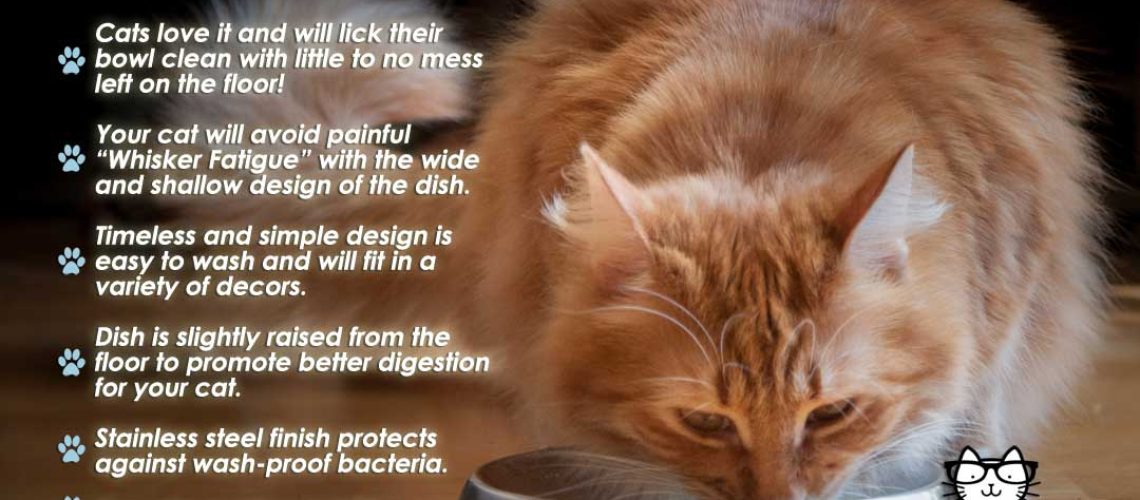Do you ever wonder why your cat sometimes seems irritable or avoids certain food bowls? Have you noticed them pawing at their face or shaking their head after eating? Well, my friend, it's time to dive into the fascinating world of whisker fatigue in cats. Understanding this topic can bring immense benefits to both you and your furry companion. By unraveling the mysteries behind whisker fatigue, you'll be able to provide your cat with the comfort they deserve during mealtime and enhance their overall well-being.
Whisker fatigue is not just another quirky behavior; it's an essential concept that can significantly impact your cat's daily life. Cats possess specialized sensory organs called whiskers, which are highly sensitive and play a crucial role in navigating their surroundings. These whiskers act as radar systems, helping them gauge distances and detect potential dangers. However, when these magnificent whiskers become overstimulated or cramped in narrow food bowls, it can cause discomfort and stress for our feline friends.
By delving into the realm of whisker fatigue, we'll explore how simple changes in our cats' feeding environment can make a world of difference. We'll uncover practical tips and tricks to ensure your cat enjoys mealtime without any unnecessary stress or discomfort. You might be surprised to learn that even seemingly small adjustments like using wider bowls or opting for shallow dishes can have a significant impact on your cat's happiness.
So join me on this enlightening journey as we unlock the secrets behind whisker fatigue in cats. Together, we'll discover how understanding this topic can revolutionize mealtime for our beloved companions, allowing them to savor each bite with contentment and joy.
Key Takeaways:
- Whisker fatigue is a condition that affects cats when their sensitive whiskers are overstimulated.
- Common symptoms of whisker fatigue include food aggression, reluctance to eat from a deep bowl, and pawing at the food.
- Using shallow or wide bowls can help alleviate whisker fatigue in cats by reducing the contact of their whiskers with the sides of the bowl.
- Giving your cat multiple small meals throughout the day instead of one large meal can also prevent whisker fatigue.
- Regularly cleaning and maintaining your cat's feeding area can help prevent bacteria buildup, which can contribute to whisker fatigue.
Understanding Whisker Fatigue in Cats
What are Whiskers and Why are They Important for Cats?
Cats have long, sensitive hairs called whiskers on either side of their face. These whiskers, also known as vibrissae, are not just for looks - they serve an important purpose in helping cats navigate their surroundings. Whiskers are highly sensitive and can detect even the slightest changes in air currents. This allows cats to gauge the size of openings, determine if they can fit through narrow spaces, and help them judge distances accurately. Whiskers also play a crucial role in a cat's sense of touch, providing information about the texture and shape of objects they come into contact with.
How Whisker Fatigue Affects Cats
Whisker fatigue is a condition that occurs when a cat's whiskers become overstimulated or stressed. Imagine constantly bumping your fingers against the sides of narrow doorways - it would be uncomfortable and irritating after a while! Similarly, when a cat's whiskers repeatedly brush against the sides of food bowls or other objects while eating or drinking, it can cause discomfort and stress. This can lead to symptoms such as reluctance to eat or drink from certain bowls, pawing at the food bowl excessively, or even avoiding mealtime altogether.
How a Cat's Whiskers Help Them Navigate the World
The Incredible Sensitivity of Cat Whiskers
Cat whiskers are incredibly sensitive due to specialized nerve endings at their base. These nerve endings send signals to the brain, providing cats with valuable information about their environment. The length of a cat's whiskers is roughly equal to its body width, allowing them to easily determine whether they can fit into tight spaces without getting stuck. When exploring unfamiliar areas or hunting prey, cats rely on their whiskers to navigate through narrow gaps and avoid obstacles.
The Role of Whiskers in a Cat's Sense of Touch
Whiskers are not just important for spatial awareness - they also play a vital role in a cat's sense of touch. The whiskers are so sensitive that they can detect even the slightest movements or vibrations in the air. This helps cats hunt effectively, as they can sense the presence and location of small prey nearby. Additionally, when a cat is close to an object, its whiskers can provide information about the object's texture and shape. This allows cats to explore their surroundings with precision and confidence.
Signs of Whisker Fatigue in Cats: What to Look Out For
Changes in Eating Behavior
One of the most common signs of whisker fatigue is changes in a cat's eating behavior. If your cat starts avoiding certain food bowls or becomes hesitant to eat from them, it could be a sign that their whiskers are experiencing discomfort. They may paw at the food excessively or even refuse to eat altogether. Pay attention if your cat consistently leaves food behind or seems stressed during mealtime.
Behavioral Changes During Drinking
Cats with whisker fatigue may also exhibit changes in behavior while drinking water. They may avoid deep bowls or those with narrow openings as these can cause their whiskers to brush against the sides, leading to discomfort. Look out for signs such as excessive splashing or reluctance to drink from certain bowls.
Other Possible Signs:
- Pawing at the face after eating
- Avoiding contact with objects that come into contact with their whiskers
- Becoming more skittish or irritable during mealtime
- Showing signs of stress or anxiety
The Discomfort and Stress Caused by Whisker Fatigue in Cats
The Physical Discomfort of Whisker Fatigue
When a cat's whiskers are constantly stimulated or cramped, it can lead to physical discomfort. Just like how we might feel irritated if our fingers were constantly bumped against narrow doorways, cats may experience a similar sensation when their whiskers repeatedly touch the sides of food bowls or other objects. This discomfort can make mealtime stressful for them, causing them to avoid certain bowls or exhibit changes in eating behavior.
The Emotional Impact of Whisker Fatigue
Whisker fatigue not only affects cats physically but also emotionally. Cats are highly sensitive animals, and any form of discomfort can cause stress and anxiety. When cats associate mealtime with discomfort, they may become anxious or irritable during feeding, leading to behavioral changes such as aggression or avoidance. It is important to address whisker fatigue to ensure your cat's emotional well-being and overall happiness.
Possible Factors Contributing to Whisker Fatigue in Cats
Narrow Food Bowls
One common factor contributing to whisker fatigue is the use of narrow food bowls. These bowls can cause a cat's whiskers to rub against the sides while eating, leading to discomfort and stress. Opting for wider bowls that allow your cat's whiskers to remain unobstructed can help alleviate this issue.
Stressful Mealtime Environment
The mealtime environment itself can contribute to whisker fatigue in cats. If there is excessive noise, commotion, or competition from other pets during feeding, it can cause stress and tension for your cat. Creating a calm and quiet space where your cat can eat without distractions can help reduce the likelihood of whisker fatigue.
Tips for Preventing and Relieving Whisker Fatigue in Your Cat
Choose Wide and Shallow Food Bowls
Opt for wide and shallow food bowls that allow your cat to eat comfortably without their whiskers touching the sides. This will prevent overstimulation of the whiskers and alleviate any discomfort or stress during mealtime.
Provide Multiple Water Sources
To avoid whisker fatigue while drinking, provide your cat with multiple water sources. Use shallow dishes or even pet fountains that have wide openings, allowing your cat to drink without their whiskers brushing against the sides.
Create a Calm Mealtime Environment
Ensure that your cat's mealtime environment is calm and free from distractions. Feed them in a quiet area away from loud noises or other pets. This will help create a stress-free environment where your cat can eat peacefully.
Beyond Whisker Fatigue: Promoting Your Cat's Well-being and Comfort
Regular Grooming Sessions
Regular grooming sessions not only keep your cat's coat clean but also provide an opportunity to check their whiskers for any signs of damage or irritation. Gently comb through their fur, paying attention to their face and whisker area. If you notice any issues, such as bent or broken whiskers, consult with a veterinarian.
Environmental Enrichment
Cats thrive in enriched environments that cater to their natural instincts. Provide interactive toys, scratching posts, and perches to keep them mentally stimulated and physically active. This will contribute to their overall well-being and happiness.
Remember, understanding and addressing whisker fatigue is just one way to ensure your cat's comfort. By providing a safe, stress-free environment and meeting their physical and emotional needs, you can help your feline friend lead a happy and fulfilling life.
In conclusion, whisker fatigue is a real condition that can make cats uncomfortable and stressed. By providing wide and shallow food bowls, we can help our furry friends avoid this issue and keep them happy and healthy.
How can I help my cat with whisker fatigue?
Fortunately, preventing or alleviating stress caused by whisker fatigue during feeding is simple. Just replace your cat's food and water bowls. When it's time to eat, make sure to use a flat surface or a bowl that is wide enough so that your cat's whiskers don't touch the sides of the bowl, advises Marrinan.
How does whisker fatigue affect cats?
When cats' whiskers brush against the edges of a deep bowl, it can cause discomfort and pain. In the past, it may have been seen as normal behavior for cats to paw their food out of the bowl and eat off the floor. However, we now understand that this is actually a sign of whisker fatigue.
How serious is whisker fatigue?
While it may cause discomfort and anxiety for your cat, they are not physically ill in the conventional sense. However, whisker fatigue can greatly impact a cat's overall well-being. In severe cases, it can lead to dehydration or malnutrition if the cat refuses to eat or drink.
What does whisker stress look like?
Your cat might appear to be a choosy eater, but it could actually be sensitive to its whiskers touching the edges of its food bowl. Some typical indications of this sensitivity include scooping food onto the floor, taking a few bites and then leaving, and returning to eat later.
What type of bowls cause whisker fatigue?
Whisker fatigue in cats is often caused by using small, deep bowls for their food and water. This can lead to discomfort and sensitivity in their whiskers.
What bowls cause whisker fatigue?
It is said that the main cause of whisker fatigue in cats is the use of deep food bowls and water dishes. Although this sensory input may bother some sensitive cats, the concept of whisker fatigue itself may be overstated.

















